Sewing machine

A sewing machine is a machine used to stitch fabric and other materials together with thread. Sewing machines were invented during the first Industrial Revolution to decrease the amount of manual sewing work performed in clothing companies. Since the invention of the first working sewing machine, generally considered to have been the work of Englishman Thomas Saint in 1790,[1] the sewing machine has greatly improved the efficiency and productivity of the clothing industry.
Home sewing machines are designed for one person to sew individual items while using a single stitch type. In a modern sewing machine the fabric easily glides in and out of the machine without the inconvenience of needles and thimbles and other such tools used in hand sewing, automating the process of stitching and saving time.
Industrial sewing machines, by contrast, are larger, faster, more complex, and more varied in their size, cost, appearance, and task.
The fabric shifting mechanism may be a workguide or may be pattern-controlled (e.g., jacquard type). Some machines can create embroidery-type stitches. Some have a work holder frame. Some have a workfeeder that can move along a curved path, while others have a workfeeder with a work clamp. Needle guards, safety devices to prevent accidental needle-stick injuries, are often found on modern sewing machines.
History and development
A historical change of view
(An old science-class story:)
People who wanted to invent sewing machines kept failing because they always tried to imitate the motions of hand-sewing, pushing the needle through the fabric and drawing the thread along behind through the eye at the back end of the needle. It seemed obvious until somebody first thought of putting the eye in the nose of the needle and using two threads instead of just one. A completely unnatural, indirect approach that when it comes right down to it, works great!

In 1790 English inventor Thomas Saint was the first to patent a design for a sewing machine but he did not advertise his invention.[2] It was meant for leather and canvas. It is likely that Saint had a working model but there is no evidence of one; he was a skilled cabinet maker and included many practically functional features: an overhanging arm, a feed mechanism (adequate for short lengths of leather), a vertical needle bar, and a looper. (In 1874 a sewing machine manufacturer, William Newton Wilson, found Saint's drawings in the London Patent Office, made adjustments to the looper, and built a working machine, currently owned by the London Science Museum.)

An Austrian tailor Josef Madersperger began developing the first sewing machine in 1807. He presented the first working machine in 1814. In 1830 Barthélemy Thimonnier, a French tailor, patented a sewing machine that sewed straight seams using chain stitch. By 1841, Thimonnier had a factory of 80 machines sewing uniforms for the French Army.[3] The factory was destroyed by rioting French tailors afraid of losing their livelihood. Thimonnier had no further success with his machine.
The first American lockstitch sewing machine was invented by Walter Hunt in 1832.[4] His machine used an eye-pointed needle (with the eye and the point on the same end) carrying the upper thread and a falling shuttle carrying the lower thread. The curved needle moved through the fabric horizontally, leaving the loop as it withdrew. The shuttle passed through the loop, interlocking the thread. The feed let the machine down, requiring the machine to be stopped frequently and reset up. Hunt eventually lost interest in his machine and sold it without bothering to patent it.

In 1842, John Greenough patented the first sewing machine in the United States. Elias Howe, born in Spencer, Massachusetts, created his sewing machine in 1845, using a similar method to Hunt's, except the fabric was held vertically. The major improvement he made was to have the needle running away from the point, starting from the eye. After a lengthy stint in England trying to attract interest in his machine he returned to America to find various people infringing his patent, among them Isaac Merritt Singer.[5] He eventually won a case against patent infringement in 1854 and was awarded the right to claim royalties from the manufacturers using ideas covered by his patent, including Singer.
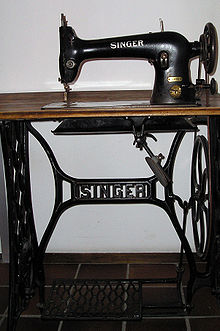
Trained as an engineer, Singer saw a rotary sewing machine being repaired in a Boston shop. He thought it to be clumsy and promptly set out to design a better one. His machine used a falling shuttle instead of a rotary one; the needle was mounted vertically and included a presser foot to hold the cloth in place. It had a fixed arm to hold the needle and included a basic tensioning system. This machine combined elements of Thimonnier's, Hunt's, and Howe's machines. He was granted an American patent in 1851 and it was suggested he patent the foot pedal (or treadle) used to power some of his machines; however, it had been in use for too long for a patent to be issued. When Howe learned of Singer's machine he took him to court. Howe won and Singer was forced to pay a lump sum for all machines already produced. Singer then took out a license under Howe's patent and paid him $1.15 per machine. Singer then entered a joint partnership with a lawyer named Edward Clark. They established the first hire-purchase scheme to allow people to buy their machines through payments over time.

Meanwhile Allen B. Wilson had developed a shuttle that reciprocated ("vibrated") in a short arc, which was an improvement over Singer's and Howe's. However, John Bradshaw had patented a similar device and was threatening to sue. Wilson decided to try a new method. He went into partnership with Nathaniel Wheeler to produce a machine with a rotary hook instead of a shuttle. This was far quieter and smoother than the other methods, and the Wheeler and Wilson Company produced more machines in 1850s and 1860s than any other manufacturer. Wilson also invented the four-motion feed mechanism; this is still seen on every machine today. This had a forward, down, back, and up motion, which drew the cloth through in an even and smooth motion. Charles Miller patented the first machine to stitch buttonholes.[6] Through the 1850s more and more companies were being formed and were trying to sue each other. This triggered a patent thicket known as the Sewing Machine War.[7]
In 1856 the Sewing Machine Combination was formed, consisting of Singer, Howe, Wheeler, Wilson, Grover and Baker. These four companies pooled their patents, meaning that all the other manufacturers had to obtain a license and pay $15 per machine. This lasted until 1877 when the last patent expired.
James Edward Allen Gibbs (1829–1902), a farmer from Raphine in Rockbridge County, Virginia patented the first chain-stitch single-thread sewing machine on June 2, 1857. In partnership with James Willcox, Gibbs became a principal in Willcox & Gibbs Sewing Machine Company. Willcox & Gibbs commercial sewing machines are still used in the 21st century.

William Jones started making sewing machines in 1859 and in 1860 formed a partnership with Thomas Chadwick. As Chadwick & Jones they manufactured sewing machines at Ashton-under-Lyne until 1863. Their machines used designs from Howe and Wilson produced under licence.[8] Thomas Chadwick later joined Bradbury & Co. William Jones opened a factory in Guide Bridge, Manchester in 1869.[9] In 1893 a Jones advertising sheet claimed that this factory was the "Largest Factory in England Exclusively Making First Class Sewing Machines".[10] The firm was renamed as the Jones Sewing Machine Co. Ltd and was later acquired by Brother Industries of Japan, in 1968.[11]
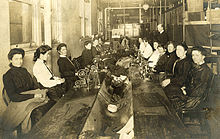
Clothing manufacturers were the first sewing machine customers, and used them to produce the first ready-to-wear clothing and shoes. In the 1860s consumers began purchasing them, and the machines—ranging in price from £6 to £15 in Britain depending on features—became very common in middle-class homes. Owners were much more likely to spend free time with their machines to make and mend clothing for their families than to visit friends, and women's magazines and household guides such as Mrs Beeton's offered dress patterns and instructions. A sewing machine could produce a man's shirt in about one hour, compared to 14 1/2 hours by hand.[12]

In 1877 the world’s first crochet machine was invented and patented by Joseph M. Merrow, then-president of what had started in the 1840s as a machine shop to develop specialized machinery for the knitting operations. This crochet machine was the first production overlock sewing machine. The Merrow Machine Company went on to become one of the largest American Manufacturers of overlock sewing machines, and continues to be a global presence in the 21st century as the last American over-lock sewing machine manufacturer.
In 1885 Singer patented the Singer Vibrating Shuttle sewing machine, which used Allen B. Wilson's idea for a vibrating shuttle and was a better lockstitcher than the oscillating shuttles of the time. Millions of the machines, perhaps the world's first really practical sewing machine for domestic use, were produced until finally superseded by rotary shuttle machines in the 20th century. Sewing machines continued being made to roughly the same design, with more lavish decoration appearing until well into the 1900s.

The first electric machines were developed by Singer Sewing Co. and introduced in 1889.[13] During the war years, 1914 thru 1919, sewing machine factories switched to making war materials, but by the end of the war Singer was offering hand, treadle and electric machines for sale. At first the electric machines were standard machines with a motor strapped on the side, but as more homes gained power, they became more popular and the motor was gradually introduced into the casing.
Stitch formation
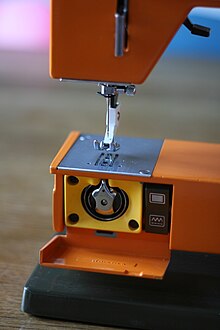
Sewing machines can make a great variety of plain or patterned stitches. Ignoring strictly decorative aspects, over three dozen distinct stitch formations are formally recognized by the ISO 4915:1991 standard, involving one to seven separate threads to form the stitch.[14] Plain stitches fall into four general categories: lockstitch, chainstitch, overlock, and coverstitch.
Lockstitch
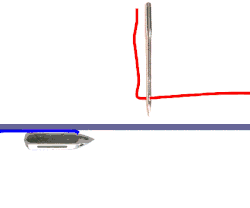
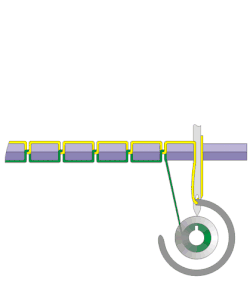
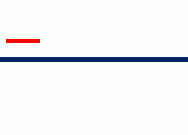
Lockstitch is the familiar stitch performed by most household sewing machines and most industrial "single needle" sewing machines from two threads, one passed through a needle and one coming from a bobbin or shuttle. Each thread stays on the same side of the material being sewn, interlacing with the other thread at each needle hole by means of a bobbin driver. As a result, a lockstitch can be formed anywhere on the material being sewn; it does not need to be near an edge. Stitch making : The drive shaft has a vertical crank attached to it, going down under the base plate. Again, by a series of levers, this connects to a hook ring. The hook ring picks up the upper thread and guides it round the bobbin holding the lower thread. Using the up and down movement of the needle and the rotation of the hook ring the two threads are looped together to form the stitch.
Chainstitch
Chainstitch was used by early sewing machines and has two major drawbacks:
- The stitch is not self-locking, and if the thread breaks at any point or is not tied at both ends, the whole length of stitching comes out. It is also easily ripped out.[15]
- The direction of sewing cannot be changed much from one stitch to the next, or the stitching process fails.
A better stitch was found in the lockstitch. The chainstitch is still used today in clothing manufacture, though due to its major drawback it is generally paired with an overlock stitch along the same seam.
Overlock
Overlock, also known as "serging" or "serger stitch", can be formed with one to four threads, one or two needles, and one or two loopers. Overlock sewing machines are usually equipped with knives that trim or create the edge immediately in front of the stitch formation. Household and industrial overlock machines are commonly used for garment seams in knit or stretchy fabrics, for garment seams where the fabric is light enough that the seam does not need to be pressed open, and for protecting edges against raveling. Machines using two to four threads are most common, and frequently one machine can be configured for several varieties of overlock stitch. Overlock machines with five or more threads usually make both a chainstitch with one needle and one looper, and an overlock stitch with the remaining needles and loopers. This combination is known as a "safety stitch". Household overlock machines are widely used.
Zigzag stitch
A zigzag stitch is variant geometry of the lockstitch. It is a back-and-forth stitch used where a straight stitch will not suffice, such as in preventing raveling of a fabric, in stitching stretchable fabrics, and in temporarily joining two work pieces edge-to-edge.

When creating a zigzag stitch, the back-and-forth motion of the sewing machine's needle is controlled by a cam. As the cam rotates, a fingerlike follower, connected to the needle bar, rides along the cam and tracks its indentations. As the follower moves in and out, the needle bar is moved from side to side.[16] Very old sewing machines lack this hardware and so cannot natively produce a zigzag stitch, but there are often shank-driven attachments available which enable them to do so.
Coverstitch
Coverstitch is formed by two or more needles and one or two loopers. Like lockstitch and chainstitch, coverstitch can be formed anywhere on the material being sewn. One looper manipulates a thread below the material being sewn, forming a bottom cover stitch against the needle threads. An additional looper above the material can form a top cover stitch simultaneously. The needle threads form parallel rows, while the looper threads cross back and forth all the needle rows. Coverstitch is so-called because the grid of crossing needle and looper threads covers raw seam edges, much as the overlock stitch does. It is widely used in garment construction, particularly for attaching trims and flat seaming where the raw edges can be finished in the same operation as forming the seam.
Feed mechanisms
Besides the basic motion of needles, loopers and bobbins, the material being sewn must move so that each cycle of needle motion involves a different part of the material. This motion is known as feed, and sewing machines have almost as many ways of feeding material as they do of forming stitches. For general categories, there are: drop feed, needle feed, walking foot, puller, and manual. Often, multiple types of feed are used on the same machine. Besides these general categories, there are also uncommon feed mechanisms used in specific applications like edge joining fur, making seams on caps, and blindstitching.
Drop feed
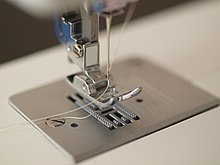
The drop feed mechanism is used by almost all household machines and involves a mechanism below the sewing surface of the machine. When the needle is withdrawn from the material being sewn, a set of "feed dogs" is pushed up through slots in the machine surface, then dragged horizontally past the needle. The dogs are serrated to grip the material, and a "presser foot" is used to keep the material in contact with the dogs. At the end of their horizontal motion, the dogs are lowered again and returned to their original position while the needle makes its next pass through the material. While the needle is in the material, there is no feed action. Almost all household machines and the majority of industrial machines use drop feed. Differential feed is a variation of drop feed with two independent sets of dogs, one before and one after the needle. By changing their relative motions, these sets of dogs can be used to stretch or compress the material in the vicinity of the needle. This is extremely useful when sewing stretchy material, and overlock machines (heavily used for such materials) frequently have differential feed.
Needle feed
A needle feed, used only in industrial machines, moves the material while the needle is in the material. In fact, the needle may be the primary feeding force. Some implementations of needle feed rock the axis of needle motion back and forth, while other implementations keep the axis vertical while moving it forward and back. In both cases, there is no feed action while the needle is out of the material. Needle feed is often used in conjunction with a modified drop feed, and is very common on industrial two needle machines. The advantage of needle feed over drop feed is that multiple layers of material, especially slippery material, can not slide with respect to one another, since the needle holds all layers together while the feed action takes place. Household machines do not use needle feed as a general rule.
Walking foot

A walking foot replaces the stationary presser foot with one that moves along with whatever other feed mechanisms the machine already has. As the walking foot moves, it shifts the workpiece along with it. It is most useful for sewing heavy materials where needle feed is mechanically inadequate, for spongy or cushioned materials where lifting the foot out of contact with the material helps in the feeding action, and for sewing many layers together where a drop feed will cause the lower layers to shift out of position with the upper layers.
Puller feed
Some factory machines and a few household machines are set up with an auxiliary puller feed, which grips the material being sewn (usually from behind the needles) and pulls it with a force and reliability usually not possible with other types of feed. Puller feeds are seldom built directly into the basic sewing machine. Their action must be synchronized with the needle and feed action built into the machine to avoid damaging the machine. Pullers are also limited to straight seams, or very nearly so. Despite their additional cost and limitations, pulling feeds are very useful when making large heavy items like tents and vehicle covers.
Manual feed
A manual feed is used primarily in freehand embroidery, quilting, and shoe repair. With manual feed, the stitch length and direction is controlled entirely by the motion of the material being sewn. Frequently some form of hoop or stabilizing material is used with fabric to keep the material under proper tension and aid in moving it around. Most household machines can be set for manual feed by disengaging the drop feed dogs. Most industrial machines can not be used for manual feed without actually removing the feed dogs.
Impact on the United States
Out of the inventions created during the industrial revolution, the invention of the sewing machine had one of the largest impacts on the United States. The invention of the sewing machine caused both positive and negative effects on the United State’s economy and citizens.
Era before invention
Before sewing machines were invented, women had to spend a large amount of their time on maintaining family clothing. Middle-class housewives, even with the aid of a hired seamstress, would have to spend several days of every month on this task. It would take a seamstress some 14 hours to make a dress shirt for a man; a dress took 10 hours,[17] and a pair of summer pants nearly three hours.[18] Most individuals would have only two sets of clothing: a work outfit and a Sunday outfit.
Era after invention
Sewing machines reduced the time for making a dress shirt to one hour 15 minutes, the time to make a dress to an hour,[17] and the time for a pair of summer pants to 38 minutes.[18] This reduced labor resulted in women having a diminished role in household management, and allowed more hours for their own leisure as well as the ability to seek more employment.[17]
Industrial use of sewing machines further reduced the burden placed upon housewives, moving clothing production from housewives and seamstresses to large-scale factories.[17] The movement to large-scale factories also resulted in a decrease the amount of time clothing production took, which caused the prices for clothing to drop significantly. This is because manufacturers were able to decrease the number of workers needed to produce the same amount of clothing, resulting in reduced costs. As well manufacturers could produce even more clothing, flooding the marketplace with more clothes than currently demanded. With the supply being higher than the demand for clothing, it was required that the cost of clothing decrease in order to clear the market and avoid surplus.[18] One example of this decrease in production costs is in New Haven, Connecticut in 1860. By installing sewing machines in the factory a shirt manufacturer needed only employ 400 instead of 2000 workers to create 800 dozen shirts. Despite an increase in wages in this instance, the manufacturer’s costs decreased from 6,000 dollars to 1,600 dollars.[18]
The initial effects of sewing machines on workers were both positive and negative, however in the long run the negative effects decreased. Many of the women who had previously been busy at home could now seek employment in factories, increasing the income for their family. This allowed for families to be able to afford more sets of clothing and items than they previously could.[18] For seamstresses, home sewing machines allowed them to produce clothing for the average person during periods when demand for fitted clothes was low, effectively increasing their earnings. When industrial sewing machines initially became popular many seamstresses working in factories as well as those working at home lost their jobs as it enabled fewer workers could produce the same output.[17] In the long run these now unemployed workers along with thousands of men and children, would eventually be able to gain employment in jobs created as the clothing industry grew.[18]
The sewing machine’s effects on the clothing industry resulted in major changes for other industries as well. Cotton production needed to increase in order to match the demand of the new clothing factories. As a result cotton became planted in new areas where it hadn’t previously been farmed. Other industries involved in the process benefitted as well such as metal companies who provided for parts of the machines and shippers to move the increased amounts of goods.[19] Gun makers visited clothing factories in order to perfect their own mass production techniques.[20] In addition to being important for clothing production, sewing machines also became important in the manufacturing of furniture with upholstery, curtains and towels, toys, books, and many other products.[19]
Gallery
-
A Merrow 70-Class machine (2007).
-
Computerized home sewing machines (2005).
-
A sewing machine for shoemaking and shoe repair.
-
A bobbin in a chamber beneath the foot plate also holds thread.
-
Wilcox & Gibbs ornate treadle machine
-
1922 Singer with Lotus pattern.
-
Wilcox and Gibbs straw hat binder (c. 1870).
-
Yugoslav made Bagat Danica
Sewing machine needle
Sewing machines use special needles tailored to their needs and to the character of the material being sewn.
References
- ^ A brief history of the sewing machine, ISMACS.
- ^ "Sewing Machines", Moah (virtual exhibit).
- ^ [1], "Encyclopædia Britannica. Encyclopædia Britannica Online. Encyclopædia Britannica Inc., 2011. Web. 31 Dec. 2011.".
- ^ A Brief History of the Sewing Machine
- ^ e.g. Bill Bryson: Made in America: an Informal History of the English Language in the United States, Black Swan, 1998, ISBN 0-552-99805-2, p.110.
- ^ U.S. patent 10,609
- ^ Adam Mossoff, A Stitch in Time: The Rise and Fall of the Sewing Machine Patent Thicket; summarized and discussed at Sewing Machine Blogging, The Volokh Conspiracy.
- ^ Veteran Sewing Machines by E Brian Jewel pp. 99
- ^ Sewing Machines by K. R Gilbert (1970) published for the London Science Museum pp12
- ^ Sewalot at: http://www.sewalot.com/jones_sewing_machines.htm
- ^ Brother Industries at: http://www.brother.co.uk/g3.cfm/s_page/204540
- ^ Draznin, Yaffa Claire (2001). Victorian London's Middle-Class Housewife: What She Did All Day (#179). Contributions in Women's Studies. Westport, Connecticut: Greenwood Press. pp. 66–68. ISBN 0-313-31399-7.
- ^ Sewing Machine History - Invention of the Sewing Machine
- ^ For a summary of stitch types see [2] or [3]
- ^ [4] The Home Sewing Machine
- ^ Reader's Digest Complete Guide to Sewing. Pleasantville, New York: The Reader's Digest Association, Inc., 32-36.
- ^ a b c d e Sewing Machine
- ^ a b c d e f 19th Century Fashion and the Sewing Machine
- ^ a b The Sewing Machine and Its Impact on America
- ^ Sewing Machine History
External links
- Sewing Machines, Historical Trade Literature Smithsonian Institution Libraries
- Old Sewing Machines and How They Work – with animations.
- Servant in the house: A brief history of the sewing machine. From The Annual Report of the Smithsonian Institution, 1929
- "Lockstitch sewing machine mechanism", How stuff works.
- History of the Sewing Machine
- History of Singer sewing machines









